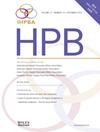切除切缘宽度对微血管侵犯亚分类孤立性肝癌手术疗效的影响。
IF 2.4
3区 医学
Q2 GASTROENTEROLOGY & HEPATOLOGY
引用次数: 0
摘要
背景:肝细胞癌(HCC)微血管侵犯(MVI)患者切除术切缘宽度对手术结果的影响仍有争议。本研究探讨MVI分型是否影响单发肝癌根治性切除后的预后。方法:对2018年5月至2019年12月行肝切除术的601例单发HCC患者进行分析,将其分为无血管侵犯(NVI)组、微血管侵犯(MI)组和显微门静脉侵犯(MPVI)组。评估切除切缘宽度对无进展生存期(PFS)和总生存期(OS)的影响。结果:MVI患者133例(22.1%)。NVI、MI和MPVI患者的3年OS率分别为87.4%、70.2%和53.9%,PFS率分别为59.5%、47.7%和29.9% (p < 0.0001)。宽裕度(≥1 cm)改善心肌梗死患者的OS和PFS (80.7% vs 50.0%;64.5% vs. 23.7%;p < 0.05),而NVI组和MPVI组均无差异。多因素分析显示,肿瘤大小、MI和MPVI是影响根治性肝切除术后RFS和OS的独立危险因素。结论:与MI和NVI相比,MPVI术后预后较差。宽切除切缘提高了心肌梗死患者的生存率,但对NVI或MPVI患者没有任何益处。本文章由计算机程序翻译,如有差异,请以英文原文为准。
The impact of resection margin width on surgical outcomes for solitary hepatocellular carcinoma with sub-classification of microvascular invasion
Background
The impact of resection margin width on surgical outcomes in hepatocellular carcinoma (HCC) patients with microvascular invasion (MVI) remains controversial. This study explores whether MVI sub-classification influences prognosis after curative resection for solitary HCC.
Methods
We analyzed 601 solitary HCC patients who underwent hepatectomy between May 2018 and December 2019, classifying them into no vascular invasion (NVI), microvessel invasion (MI), and microscopic portal vein invasion (MPVI) groups. The effects of resection margin width on progression-free survival (PFS) and overall survival (OS) were evaluated.
Results
MVI was identified in 133 patients (22.1 %). The 3-year OS rates for patients with NVI, MI, and MPVI were 87.4 %, 70.2 %, and 53.9 %, while PFS rates were 59.5 %, 47.7 %, and 29.9 %, respectively (p < 0.0001). A wide margin (≥1 cm) improved OS and PFS in MI patients (80.7 % vs. 50.0 %; 64.5 % vs. 23.7 %; p < 0.05) but not in NVI or MPVI groups. Multivariate analysis indicated that tumor size, MI and MPVI were the independent risk factors affecting RFS and OS after curative liver resection.
Conclusion
MPVI was associated with a worse prognosis after resection compared to MI and NVI. A wide resection margin improved survival in MI patients but had no benefit in NVI or MPVI cases.
求助全文
通过发布文献求助,成功后即可免费获取论文全文。
去求助
来源期刊

Hpb
GASTROENTEROLOGY & HEPATOLOGY-SURGERY
CiteScore
5.60
自引率
3.40%
发文量
244
审稿时长
57 days
期刊介绍:
HPB is an international forum for clinical, scientific and educational communication.
Twelve issues a year bring the reader leading articles, expert reviews, original articles, images, editorials, and reader correspondence encompassing all aspects of benign and malignant hepatobiliary disease and its management. HPB features relevant aspects of clinical and translational research and practice.
Specific areas of interest include HPB diseases encountered globally by clinical practitioners in this specialist field of gastrointestinal surgery. The journal addresses the challenges faced in the management of cancer involving the liver, biliary system and pancreas. While surgical oncology represents a large part of HPB practice, submission of manuscripts relating to liver and pancreas transplantation, the treatment of benign conditions such as acute and chronic pancreatitis, and those relating to hepatobiliary infection and inflammation are also welcomed. There will be a focus on developing a multidisciplinary approach to diagnosis and treatment with endoscopic and laparoscopic approaches, radiological interventions and surgical techniques being strongly represented. HPB welcomes submission of manuscripts in all these areas and in scientific focused research that has clear clinical relevance to HPB surgical practice.
HPB aims to help its readers - surgeons, physicians, radiologists and basic scientists - to develop their knowledge and practice. HPB will be of interest to specialists involved in the management of hepatobiliary and pancreatic disease however will also inform those working in related fields.
Abstracted and Indexed in:
MEDLINE®
EMBASE
PubMed
Science Citation Index Expanded
Academic Search (EBSCO)
HPB is owned by the International Hepato-Pancreato-Biliary Association (IHPBA) and is also the official Journal of the American Hepato-Pancreato-Biliary Association (AHPBA), the Asian-Pacific Hepato Pancreatic Biliary Association (A-PHPBA) and the European-African Hepato-Pancreatic Biliary Association (E-AHPBA).
 求助内容:
求助内容: 应助结果提醒方式:
应助结果提醒方式:


